The Annapurna Base Camp Trek (shortly ABC) is one of the most popular treks in Nepal. 60-70% of trekkers take the Poon hill trek and then continue to the Base Camp. There is a short and long version.
As always, my friend, the experienced Nepalese mountain guide Bharat KC from Nature Explore Trek, helped compile a comprehensive guide for those who plan to complete the Annapurna Base Camp Trek.
- Annapurna Base Camp versus Annapurna Circuit
- The best time to complete the Annapurna Base Camp
- The highlights of the trek
- What is the difficulty rate of the ABC trek?
- Necessary permits
- How to complete the ABC Trek?
- Accommodation
- How to get from Kathmandu to Pokhara
- Pokhara – the adventure capital of Nepal
- The possible itineraries to ABC
- I. The itinerary of the long Annapurna Base Camp Trek (12 days via flight to Pokhara, 14 days via road to Pokhara)
- II. The itinerary of the short Annapurna Base Camp Trek (9 days via flight, 11 days via the road)
Annapurna Base Camp versus Annapurna Circuit
There are the two most popular treks in the Annapurna region. The Annapurna Base Camp Trek goes up to 4200 meters, and you have a close view of several mountain ranges in the Himalayas. The Annapurna Circuit is a scenic trail around the Annapurna range going through the unique Thorong La Pass (5614 meters). It can take 7-21 days, depending on what sections you complete.
The best time to complete the Annapurna Base Camp
September-January and March-May are the best periods for this trek. December and January are dry and clear but colder. Temperatures significantly drop in February, so it is better to skip this month.
The monsoon time (June-August) is not ideal either. Due to heavy rainfalls, the trails get muddy and slippery, and the view is less clear. The monsoon time also involves a higher risk for landslides, and the leeches can make your trekking inconvenient. If you have to come to Nepal during the summer months, then choose the Dolpo and Mustang treks. These regions have a uniquely dry climate the whole year around without being affected by the monsoon.
Read more about the best short and long treks in Nepal
The highlights of the trek
- Enjoy the panoramic view from Poon Hill.
- The lonely standing Fishtail Mountain (Machhapuchhre) shows up several days during the trekking
- This trail gives the best view of the Annapurna I. and a nice view of other mountains: Machhapuchhre, Hiunchuli, and Dhaulagiri.
- The Annapurna Base Camp is at a lower altitude (4200 m), which makes it easier to complete. Other base camps are over 5000 m.
- The trail gets colorful during April and the beginning of May when rhododendron forests are blossoming.
- Hikers from the whole world meet and interact on this touristic trail, making it a truly international experience.
- Pokhara city at the lake offers so much to do before or after you completed ABC. You can visit the world peace pagoda, Buddhist temples or relax on the lakes of Pokhara, and learn about the climbing history of the Everest region in the excellent Mountain Museum.
- Have a bath in the hot spring of Tatopani.
- ABC passes through the Machhapuchhre Base Camp, which means you complete two Base Camps during one trip.
- Trek along the deep Kali Gandaki gorge.
- Pass by Magar and Gurung ethnic villages
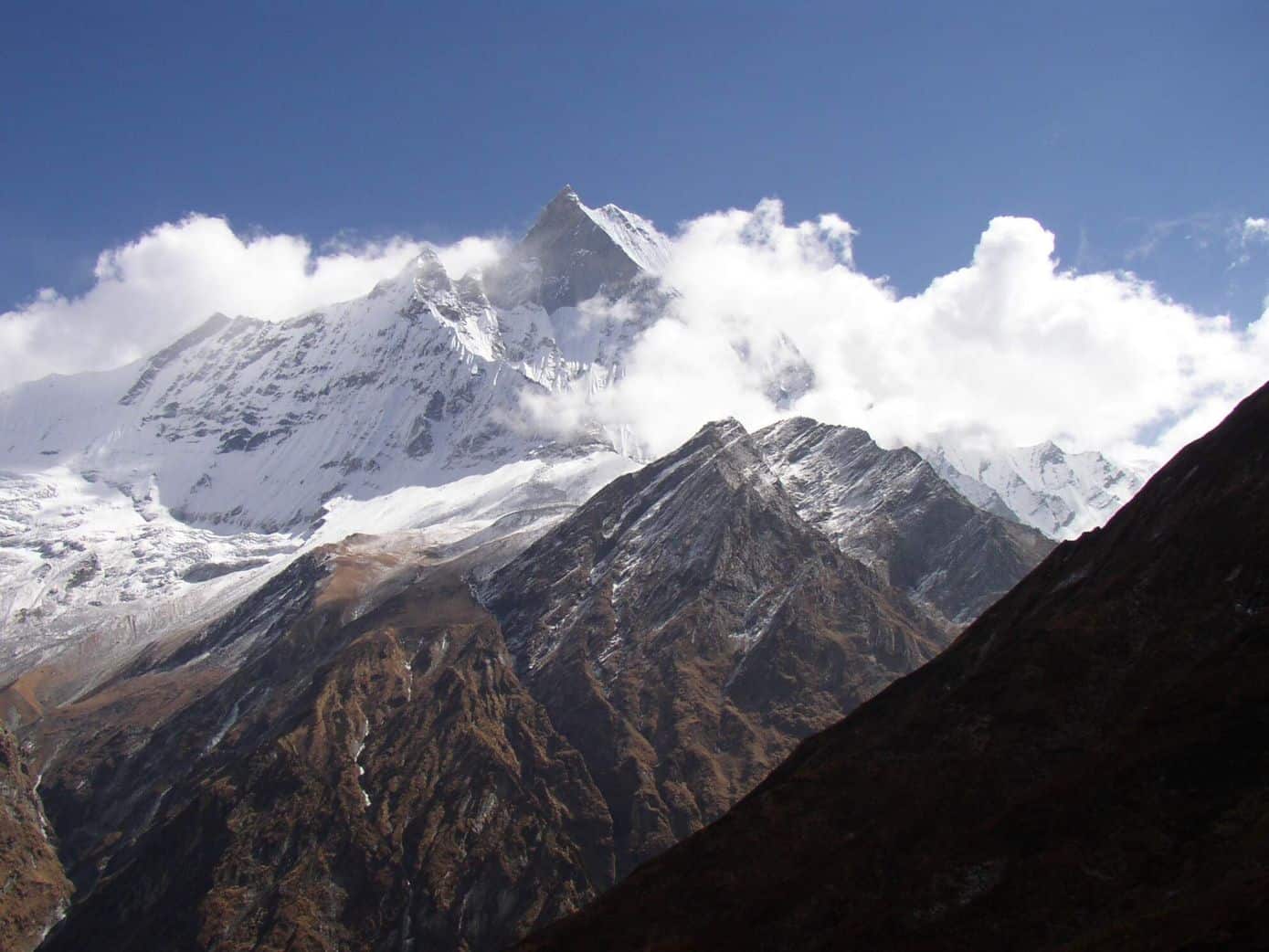
What is the difficulty rate of the ABC trek?
The difficulty rate of the long ABC: 6.5/10
The difficulty rate of the short ABC: 6/10
The Annapurna Base Camp is a moderate trek, but you need to get prepared. A couple of months before your trip, start regular exercises. Go running 2-3 times a week. The best is to climb stairs up and down as well, which makes you prepared for elevations.
There is not much you can do to get ready for the high-altitude if you come from a flat country. For that, it is essential to take time for acclimatization when you arrive in Kathmandu. You have to hike at a slow pace and drink enough water to avoid dehydration.
Read more about everything you need to know before trekking in Nepal (high-altitude sickness, hiring a guide and porter, recommended packing list, accommodation, and things to know about trekking in Nepal)
Necessary permits
You need two permits for this trek, both of which you can get from the tourism office in Pokhara. If you book a package, then your trekking agency will take care of all the necessary permits.
- The TIMS card for the Annapurna Conservation Area costs 3000 NPR (25 $) and is valid for a single entry.
- The National Park permit for the Annapurna Conservation Area (ACAP) costs 2000 NPR (20 $)
How to complete the ABC Trek?
You have the following options depending on your budget and your fitness:
1. Book a tour package through a local trekking agency
There are several trekking agencies in Pokhara and Kathmandu. They arrange everything for your trekking (accommodation, guide, porter, meals, permits, transport). But not all of them provide the same quality of service. The best trekking agencies work with only selected porters and guides. In this way, you can be sure that you get the best possible services. A professional, friendly guide and porter can make your trip.
A comprehensive guide about trekking in Nepal to get more information about hiring porters and guides
2. Hire a porter and/or a guide separately in Pokhara
You can hire guides and porters through a trekking agency or even at the trailhead to reduce your costs. But in peak season, there is a chance that you do not find any at the last minute. Porters waiting along the trails probably do not have any insurance, and you cannot know how experienced they are. Even if you decide on hiring a guide and a porter separately without a whole package, do it through a trekking agency. They have contacts and can recommend you the best ones.
Read more about porters in Nepal here
3. You trek independently and carry your backpack yourself
For solo trekking, you must be very fit as you need to carry your bag all the way. It is a well-marked touristic trail with many hikers, and there is no problem finding your way or to ask somebody. But do not forget that anything can happen in the mountains. You can get injured, get attacked by wild animals, come across a landslide or avalanche. And you are on your own. At least a porter should accompany you to make your trip more relaxing. Also, to make sure there is somebody to give you a hand.
You will need the following equipment for trekking in Nepal (based on the advice of a mountain guide in Nepal):
- down jacket
- half jacket
- sun cream
- sun hat
- sleeping bag (even if you sleep in teahouses along the popular treks, you will need it for cleanliness, and it can be cold too)
- Inner sleeping bag for more than a week trek
- hiking trousers (one pair for one week, 2 pairs for 2 weeks)
- thick hiking socks (more pairs because sometimes there is no time to dry)
- thin socks (minimum 2 pairs for a week-long hike)
- headlamp
- dry bag (5 to 7 liters)
- a backpack that your porter will carry- so please pack light
- flip-flops
- woolen hat
- trekking boots (not brand new)
- 1 pair of thick gloves
- 1 pair of thin gloves
- long T-shirt ( 2 pairs for a week)
- Short T-shirt (2 pairs for a week, 3 pairs for 2 weeks. 4 pairs for 3 weeks or more)
- 2 sweaters for a week, 4 for more than a week
- raincoat
- windproof trousers
- extra camera battery for more than a week-trek
- extra mobile battery for more than 2 weeks-trek
- swimming suit for the Tatopani hot spring
- medical kit (if necessary with medicine on doctor’s advice), otherwise the local trekking company will provide
- water purification tablet or liquid– 3 drops or one tablet in one-liter of water, and wait half an hour before drinking
Accommodation
Until Sinuwa, there are plenty of teahouses and lodges. But at the following stations, there are only 2-5 lodges with a capacity of a maximum of 20 people each. It makes it hard in the peak season (September-November and March-May) to get a private room. They place ten dormitory beds in one room and convert the dining room after dinner to a sleeping place. They accommodate up to 60 people during peak season. You have a better chance to get a decent place if you are with a local guide. He calls the guesthouses some days ahead to book it for you. As a solo trekker, you can have difficulties with accommodation.
How to get from Kathmandu to Pokhara
The Annapurna Base Camp trails start from a village around Pokhara.
1. Flight from Kathmandu to Pokhara
Pokhara is a low-lying area at 850 m with an airport that is suitable to serve bigger planes. Many other airports higher in the Himalayas can only handle small jets that are prone to weather conditions. They often get canceled or delayed. The airplanes from Kathmandu to Pokhara accommodate 90 people, departs several times a day. Since the weather is more stable here, the flights are quite reliable.
The 30 minutes flight costs approximately 130 $ one way.
2. On-road from Kathmandu to Pokhara
If you are on a lower budget, you better take a local bus or a tourist bus to Pokhara.
Local buses leave from the New Bus Station in Kathmandu to Pokhara every half an hour starting from 7:30 am every day. The cheaper price (500-600 NPR) comes with possible delays, less legroom, several stops along the way when people get on and get off. The journey can be as long as 8-10 hours, and you may get some chicken or goat as a traveling mate. On the other hand, it is a perfect chance to mingle with locals.
Tourist buses leave on time, have only scheduled stops and the passengers are mainly foreigners.
Schedule of buses from Kathmandu to Pokhara
| Transport Type | Departure time | Place of departure in Kathmandu | Place of arrival in Pokhara | Fare | Facility |
| Tourist Bus | 7:00 | Sorakhutte | Pokhara Tourist Bus Park | NPR 800 (7 USD) | Comfortable Seat, A/C, Stop for Lunch at Restaurant in Highway |
| Deluxe Tourist Bus | 7:30 | Durbar Marg | Pokhara Tourist Bus Park | USD 25 | Luxury Seat, A/C, Wifi, A bottle of Water, Free Lunch at Highway Restaurant |
| Greenline Tourist Bus | 7:30 | Tridevi Marg Thamel | Lake Side Pokhara | USD 25 | Fully A/C, Free Buffet Lunch at Riverside Spring Resort, Wi-fi onboard |
Pokhara – the adventure capital of Nepal
Pokhara is not just the starting point for your ABC trek. You should add some extra days before or after the trek to relax and visit some of the attractions of Pokhara, the adventure capital of Nepal:
- Sarangkot is a perfect spot for a sunrise or sunset view. Besides, it is the jumping point for paragliders
- Devi’s Falls are stunning waterfalls near Pokhara
- The Shree Gaden Dhargay Ling Tibetan Monastery
- Gopteshwar Mahadev Mandir cave temple dedicated to Lord Shiva
- Pokhara went through rapid urbanization in the 1990s, but you can still stroll around in Old Pokhara.
- The 200-year-old pagoda-style Bhimsen Temple
- Visit the Tibetan refugee camp with a tour
- Take a boat ride on the Phewa lake
- The International Mountain Museum has excellent documentation about the expeditions to the tallest summits and the ethnic groups of the Himalayas.
- The Gurkha museum about the Gurkha ethnic group and their life as soldiers in the British army. There is a significant number of Gurkha soldiers living in Pokhara.
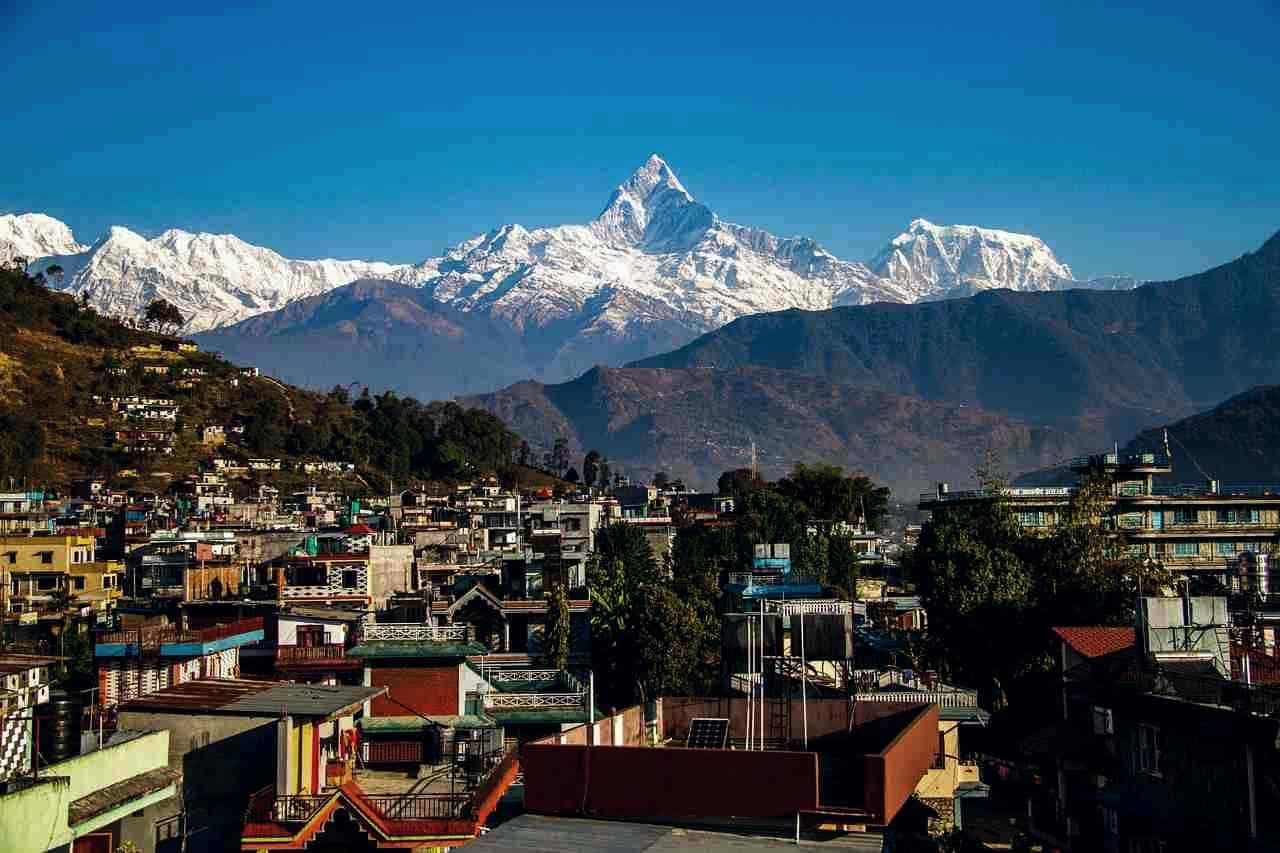
The possible itineraries to ABC
You choose from the following itinerary to the ABC that will make your trek shorter or longer: 1. Straight to the Annapurna Base Camp 2. Take a detour to Ghorepani Poon Hill
I. The itinerary of the long Annapurna Base Camp Trek (12 days via flight to Pokhara, 14 days via road to Pokhara)
1. day From Kathmandu to Pokhara (850m)/Ulleri (900m)
If you take a flight, you can start walking on the same day. If you covered the distance via road, you spend one night in Pokhara and start the trek the day after.
First, you drive 1 hour from Pokhara to the starting point of the trail, Nayapul, which means „new bridge”. From Nayapul, after 2 hours easy climbing and 2 hours steep uphill, you pass by a small village called Tikhedhunga (1520m) and a waterfall. Here you can have a short stop in a lodge or guesthouse before starting the 2 hours steep ascent to Ulleri. On the way, you will have a distant view of the Annapurna South, the Fishtail Mountain (Machhapuchhre)
Ulleri is home to the Magar ethnic group. Nepal has more than 100 ethnic groups, and Magar is the biggest, making up 7% of the population. They proudly put on their traditional dresses. Those in the lower region wear loincloths, Nepali topi, vest. The women wear Saari, head garments, and waistbands. They have a close connection to Hindu culture and follow rituals like in India. Young Magar girls like wearing amulets and lockets. Magars are honest and disciplined people who become excellent soldiers and mountaineers. But most of them make their living from agriculture.
Overnight you stay in Ulleri in a lodge.
2. day From Ulleri to Ghorepani
You continue to walk uphill for 4-5 hours. It is more attractive during April and the beginning of May, the time of rhododendron blossoms. You pass by small villages and waterfalls. Mount Annapurna South shows itself from time to time. But you get the best view from the Ghorepani viewpoint to the Nilgiri mountain range and Annapurna South (7219 m)
Ghorepani village is like a “mini Namche Bazaar”, a touristic place with small shops and crowds of trekkers, with clean and charming lodges. Some of the most popular ones: The Sunny Lodge, Hungry Eye, Mountain View. There are some super attractive lodges with a cozy fireplace and amazing views from the dining room. Imagine waking up in the morning, or having your dinner, directly seeing the Dhaulagiri mountain range.

Ghorepani was a stop along an ancient trading route, where the traders could find some water for their horses, hence its name. Ghora means horse, Pani means water in Nepali. With the construction of roads it lost its role and now depends on tourism as the principal source of income.
3. day From Ghorepani to Poon Hill – Tadapani (2600m)
You set off early morning in darkness to get in approximately one hour to the Poon Hill viewpoint for the sunrise view. The Dhaulagiri, the Annapurna range, the Fishtail Mountain (Machhapuchhre) are all around you. Take your time to enjoy the panorama, then head back to your lodge in Ghorepani.
After having breakfast, you can continue to Tadapani. The trail goes up and down for 4-5 hours.
You pass through mainly a forest area with rhododendrons and waterfalls. You can expect that monkeys jump around on the way.
From Tatapani itself, you will have a closer view of 3 remarkable mountains: The Fishtail Mountain, Annapurna South, Himchuli, and a small part of Gangapurna, which are all over 7000 meters.
Overnight in Tadapani
4. day – From Tadapani to Chhomrong (2200 m)
There is no straight walk on this day. The trail goes up and down, crossing a rhododendron forest, but you always get closer to the mountains. When the forest ends, terrace fields turn up.
Chhomrong is a Gurung village, considered the main entrance to the Annapurna Base Camp. All the trails of the ABC join in Chhomrong and follow the same path from here. It is a commercial village with shops and decent lodges. You have to walk 15-20 minutes more to reach the authentic village.
Chhomromg is the last place with a hot shower, internet (chargeable), and extra facilities such as a German bakery.
The village spreads along the hillside and has an incredible view of the mountains straight from your room.
Overnight in Chhomrong.
5. day – From Chhomrung to Sinuwa (2360 m)
You start the day descending on 2500 stone steps to Chomrung Khola (a small river). After a 4-5 hours walk (1 1/2 hours downhill, the rest uphill), you get to an open place at Sinuwa, from where you get a glimpse of the Fishtail mountain. There are several guesthouses in Sinuwa: Hotel Himala, Sherpa Guest House, Hilltop Lodge, and the Sinuwa Lodge.
All the guesthouses provide hot showers and phone service for the trekkers. From Sinuwa village itself, you can see the Fishtail Mountain and Annapurna South.
Sinuwa is divided into two parts, Lower and Upper Sinuwa. The two are 20 minutes away from each other.
Annapurna III becomes visible from the village.
6. day – From Sinuwa to Dovan (2600 m)
It is an easy day, mostly walking in bamboo and other forests that block the mountain view. You pass by Bamboo village with some lodges before arriving in Dovan.
One night in Dovan
7. day- From Dovan to Deurali (3200 m)
Continue walking through the forest for 5-6 hours, mostly uphill, without a mountain view. The forest opens up on this day with a spectacular view of the glacial river below. You climb steeply up to the Hinku Cave, a large overhanging rock. After that, you descend to the river before walking uphill again to Deurali. After Hinku Cave, the vegetation becomes sparse, and the gorge narrows to only a few hundred meters.
You pass through a Himalayan village (2900m) with a couple of lodges. This area is avalanche-risky. You have to be careful around here, especially in spring, when the increasing temperature starts to melt the snow. The last accident happened in January 2020, when 6-7 hikers got lost.
Overnight in Deurali
8. day from Deurali- Machhapuchare Base Camp (3800 m) – Annapurna Base Camp
It is an easy 3-4 hours uphill walk. The trail steadily ascends, passes close by the cliff, and occasionally becomes steep. From the Machhapuchare Base Camp (MBC), you have an unforgettable view of Mount Hiunchuli, Annapurna South, Annapurna I, Annapurna III, Gandharvachuli, and Gangapurna. You continue hiking through a gorge, the only way to the Annapurna Base Camp.
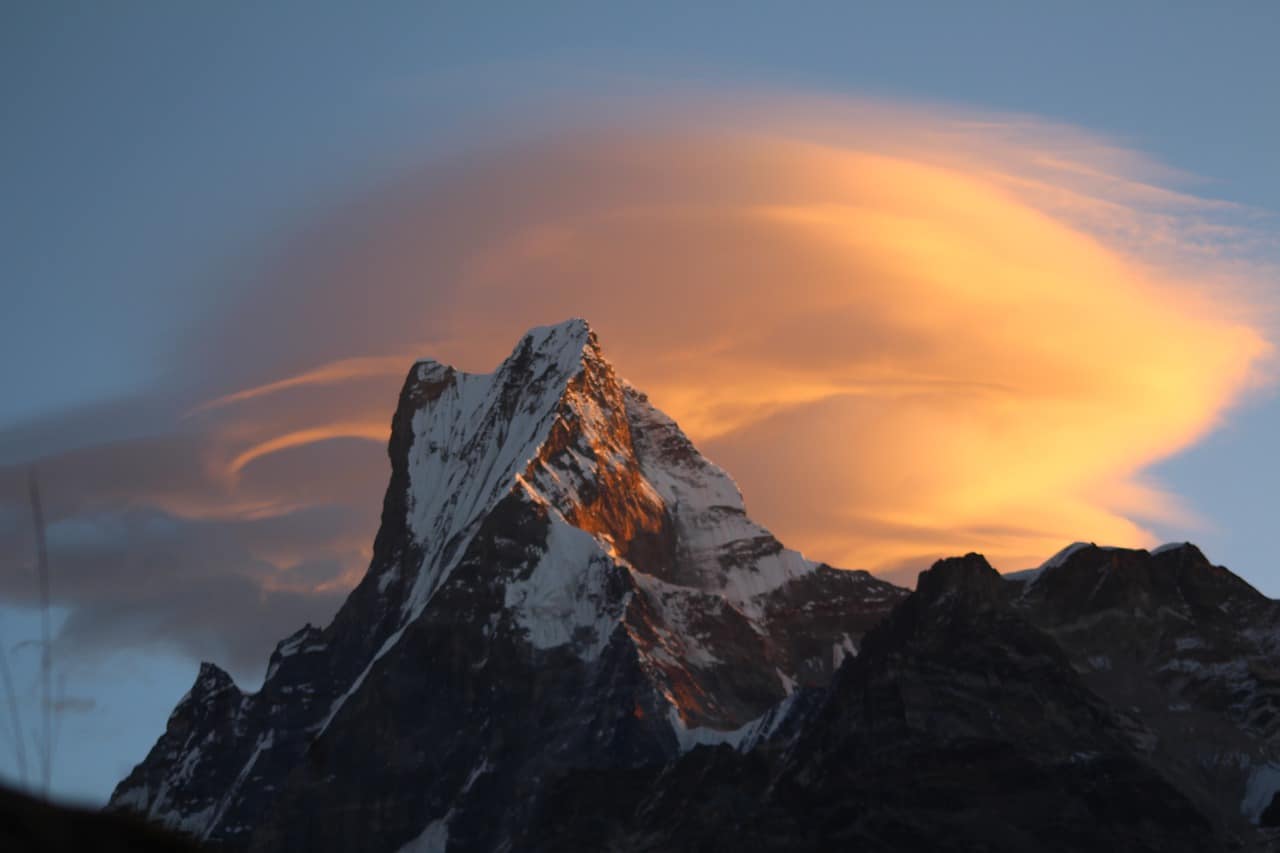
The Fishtail Mountain got its name after its form, but this is not the side from where you see this unique shape. You are very close, but it does not look like a fishtail from this side.
Overnight at ABC
9. day From Annapurna Base Camp (4200 m) to Deurali (3200 m)
Wake up early morning to enjoy the sunrise view at the Annapurna Base Camp: The Fishtail (6993 m), Annapurna I (8091 m), Annapurna II (7937 m), Hiunchuli (6441 m), and Annapurna South (7219 m), Gangapurna (7455 m) surround you. From ABC, you have the best possible view of Annapurna I, the 10th highest mountain. For long, Annapurna I was believed to be the tallest mountain in the world.
It is extremely dangerous to climb Annapurna I from any side, especially from the south face. Most try to attack the peak from the west side through the North Base Camp. But every third mountaineer never returns from the adventure. They fall victim to snowstorms and avalanches. They need to be lucky and train extremely hard to stand any chance. In 1950 Annapurna I was the first eight-thousand-high mountain to be climbed. Until now, it is the most dangerous undertaking among the over 8000 meters peaks.
Have breakfast and a cup of tea and head back to the MBC (1-1 ½ hour) and then the same way back to Deurali.
10. day From Deurali to Sinuwa (2360 m)
You continue to descend from Deurali, and within 6 hours, you reach Sinuwa.
11. day Sinuwa- JhinuDhanda/Tatopani hot spring (1760 m)
From Sinuwa, the trail goes downhill to the river and uphill to Chhomrong through forests and farmlands. After that, you ascend to Jhinudhanda instead of Tadapani south. After a 40 minutes’ walk down to the riverside, you can enjoy a hot bath and then return to Jhinudhanda.
Overnight in Jhinudhanda
12. day From Jhinudhanda to Pokhara
After 2 ½ hours walk, you cross the “new bridge” (other than Nayapul) and drive 2 ½ hours to Pokhara
II. The itinerary of the short Annapurna Base Camp Trek (9 days via flight, 11 days via the road)
1. day – From Kathmandu to Pokhara/Jhinudhanda
If you take a flight to Pokhara, you can drive the same day to the “new bridge”, located a 2 ½ hour drive from Pokhara. From the new bridge, it takes 3-4 hours to Jhinudanda village. Take a bath in the Tatopani hot spring on this day or on the way back down.
If you arrive in Pokhara via road, stay there one night and start the trek the day after.
Overnight in Jhinudhanda
2. day Jhinudanda – Chhomrong
A 1 ½ hour steep trail takes you to Chhomrong village.
The rest of the trek will be the same as described for the long trekking: Sinuwa – Dovan – Deurali – Fishtail Base Camp – Annapurna Base Camp. Once you reach the ABC, you take the same way back, i.e. Deurali- Sinuwa- Jhinudhanda. After a 2 ½ hour walk, you drive back to Pokhara.
Another alternative is to include Landruk village on the way down from the short Annapurna trek. It adds two extra days to your program.
- Jhinudhada (2000 m) to Landruk (1800 m): 4-5 hours, mostly downhill and easy uphill walk. Landruk is a Gurung village.
- From Landruk to Kade (1900 m): 2 ½ hours uphill and 2 hours downhill. A distant view of Dhaulagiri, Fishtail Mountain, and Annapurna South
- From Kade to Pokhara: 1 ½ hour – 2 hours downhill walk to Naudada and then drive to Pokhara in 40 minutes
The Annapurna Base Camp is one of the most popular treks in Nepal that takes you close to several mountains (Hiunchuli, Fishtail Mountain, Dhaulagiri and Annapurna I). You can stay at lodges and teahouses with other international trekkers. The maximum elevation of ABC is lower than most other Base Camps, which makes it easier to accomplish. Depending on your time and budget you can go for a shorter or a longer trek (7-16 days).
Pin it for later!
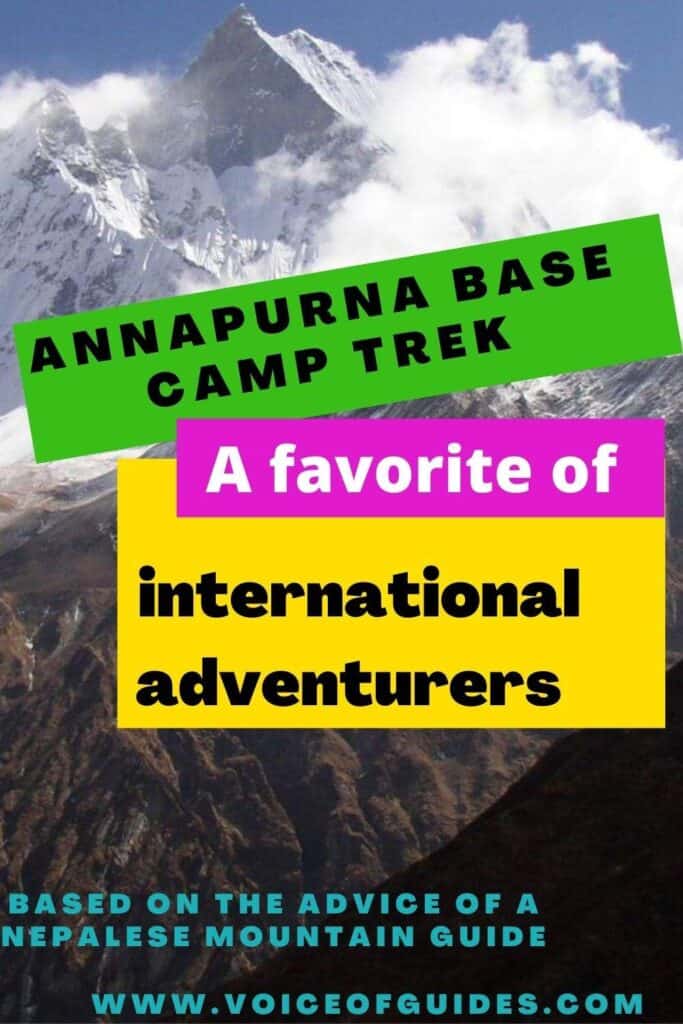

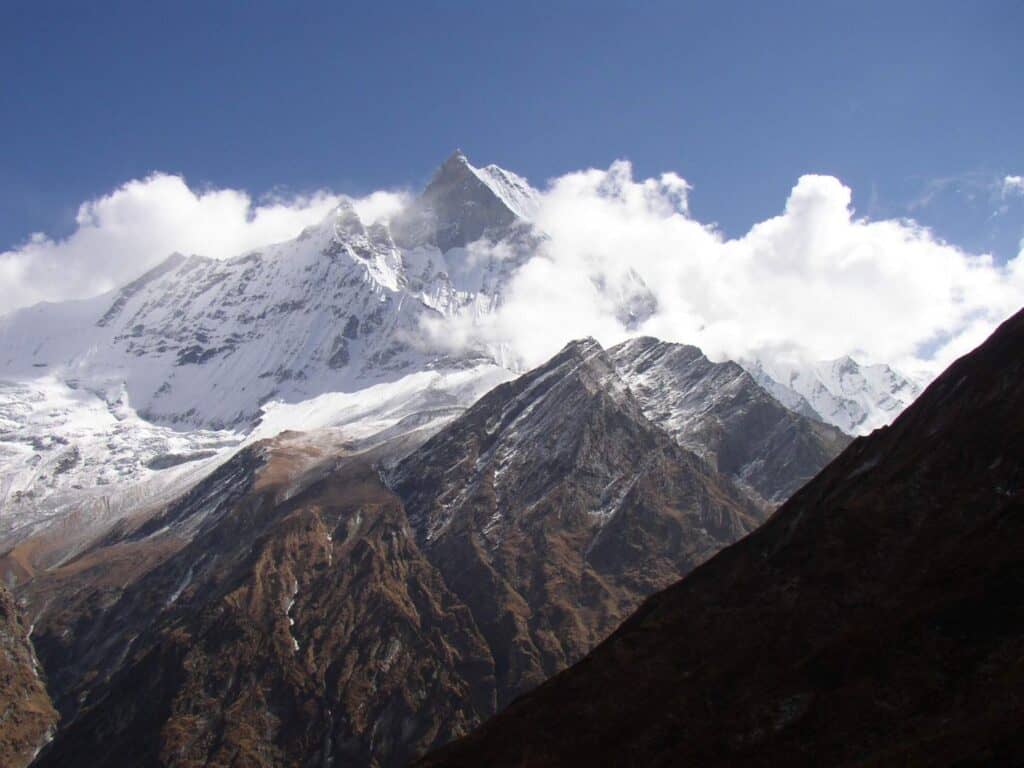

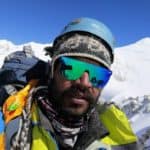
Pingback: The best short and long treks in Nepal | Voice of Guides